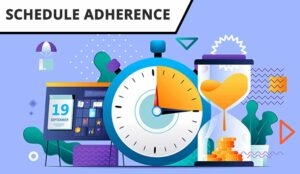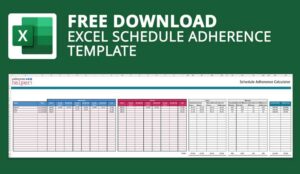Schedule adherence is a key driver of contact centre efficiency, but it’s also one of the toughest metrics to manage.
From balancing fairness to maintaining flexibility, getting it right takes more than just monitoring dashboards.
That’s why we asked our readers and selected industry professionals for their top tips to improve schedule adherence in the contact centre.
How to Improve Schedule Adherence in Your Call Centre
1. Build Adherence Into Employee Goals

As Cormac, one of our readers, rightly points out: “Adherence needs to be part of employees’ performance goals. This will ultimately drive accountability for meeting adherence targets.”
“It should also be included in team managers’ goals or commission structure. Team managers should know when their agents go on breaks, advisors are more likely to return on time if they’re aware their manager is keeping track.” – Andy Hughes, a Contact Centre Operations Manager.
By formally incorporating adherence into both advisor and manager performance objectives, you reinforce its importance across all levels of the team.
This shared accountability not only improves individual performance but also creates an environment where schedule adherence is recognised as a collective responsibility.
2. Manage Adherence in the Moment
While it’s easy to measure adherence retrospectively using standard formulas, the real value lies in managing it in real time, something Penny Downs, an experienced Contact Centre Manager, strongly advocates:
“Adherence must be measured consistently, owned by both the individual and their team leader, and integrated into performance and reward frameworks.
It should be actively managed in the moment, fed back the next day, but, most importantly, everyone should understand why it is important and the impact on their colleagues and customers when it is not met.”
Modern telephony systems, when paired with workforce management (WFM) tools, allow team leaders and resource planners to monitor adherence in real time.
These tools make it easy to spot breaches as they happen and provide an opportunity for immediate coaching. Reviewing previous day reports during morning meetings can also help reinforce accountability and support continuous improvement.
For more on calculating adherence manually, read our article: How Do I Calculate… Schedule Adherence?
3. Measure Adherence in Tandem With Conformance

David Preece, a Customer Success Manager at QStory, recommends measuring conformance alongside adherence to gain a more balanced view of advisor performance.
He explains: “While an advisor might lose adherence points for missing a scheduled break through no fault of their own, their conformance score is only impacted if they exceed the allotted break time.”
By combining these two metrics, you can distinguish between scheduling issues and actual behavioural concerns – helping you to identify where further support or coaching may be needed.
David also reminds us of a key point often overlooked in performance discussions: “The happier advisors are to come into work, the more likely they are to show up on time.” In other words, improving workplace morale can directly impact adherence.
To find out a way of measuring the happiness of your team, read our article: How to Calculate an Employee Net Promoter Score
4. Set a Reasonable Goal for Schedule Adherence

The purpose of schedule adherence is to encourage advisors to follow their planned shifts and breaks, helping the contact centre run smoothly.
However, placing too much emphasis on strict adherence can risk undermining the ultimate goal, delivering great customer service.
Andrew Leatherland from GCI highlights this balance: “Systems should allow exceptions to be entered for good reasons, for example, if a call runs long and an advisor goes late to break. But managing these exceptions can become cumbersome, potentially consuming too much of supervisors’ or WFM teams’ time.”
He adds: “Presume that schedule adherence won’t be perfect and that special circumstances will even out across the team over time. Use adherence as a useful tool, not a rigid rule.”
With that in mind, it’s wise to set realistic adherence targets, typically in the 86% to 95% range, depending on operational needs. This approach recognises the human element of contact centre work while still promoting overall efficiency.
5. Use WFM Tools to Give Advisors More Control Over Their Schedule

Traditionally, workforce management (WFM) systems were primarily used to enforce strict schedules, telling advisors exactly when and where they were expected to work. But this approach is evolving.
Jeremy Payne of Enghouse Interactive explains that modern WFM tools can actually empower advisors, helping to improve schedule adherence by giving them more control over their time.
“Staff can now be offered a choice of shifts,” he says, “with incentives or bonuses available for selecting less popular time slots, like the 8am Monday shift.”
Additionally, interactive dashboards can provide real-time visibility, allowing advisors to view their remaining leave and book time off independently.
6. Treat People Like Adults
Paul, one of our readers, suggests a simple but powerful approach to improving adherence: “Just treat people like adults. Avoid silly conversations with someone who is a minute late!”
Overreacting to minor lateness can lead to resentment, especially when the delay is due to unforeseen circumstances. While schedule adherence is crucial in a contact centre environment, where timing directly impacts service levels, it’s important to strike the right tone.
Treating advisors with respect and empathy helps build trust. By creating an environment where the team feels valued, not micromanaged, adherence often improves naturally.
For those who are consistently late, a more direct conversation may be necessary. In such cases, calmly outlining the impact of repeated lateness on team performance and customer experience is likely to be more effective than enforcing blanket rules for everyone.
To improve schedule adherence in your team, think about avoiding schedule dissatisfaction. Read how in our article: How to Avoid Schedule Dissatisfaction
7. Improve Communication From the Top Down
Clear, consistent communication is essential for improving schedule adherence, especially in larger contact centres.
As Safwaan, one of our readers, points out: “Roles and responsibilities should be clear from advisors to team leaders, and larger contact centres should have a live call escalation team that can reach out personally to discuss adherence issues.”
A key part of that communication should be ensuring everyone understands why schedule adherence matters. Advisors may assume that arriving five minutes late and staying five minutes longer makes no difference, but contact centres don’t operate that way.
Even a short delay can disrupt carefully balanced schedules, increase occupancy for other team members, and negatively affect service levels. That’s why it’s vital for advisors to understand not just the what of adherence, but the why.
Helping the team see the operational challenges behind scheduling, and how one person’s lateness can affect the entire group, can foster empathy and accountability. In close-knit teams, showing how lateness impacts colleagues directly can be one of the most effective motivators for change.
Every person is important for a successful contact centre. To help understand this, read our article: The Power of One.
8. Empower Team Leaders to Book Ad Hoc Offline Time
Craig, one of our readers, reported that his contact centre managed to improve adherence from 70% in May 2017 to 93% by year end.
One of the key drivers, according to Craig, was “empowering team managers to book ad hoc offline time through the system, so that people are booked out rather than taken off.” This flexibility ensures that time away from the phones is properly scheduled and accounted for, rather than seen as non-adherence.
Having a flexible scheduling system that allows shift swaps and real-time updates is essential. Craig also recommends creating an online community, monitored by managers, where advisors can coordinate swaps themselves. This reduces admin burdens and eliminates the need for team leaders to act as intermediaries.
In addition, resource planning teams should consider enabling shift and lunch swaps. Allowing advisors to adjust their breaks to better suit their needs, without negatively impacting service levels, creates a more engaged and accountable workforce.
Printable – Excel Schedule Adherence Spreadsheet Template
Do you want to track adherence in your contact centre?
Download our free excel schedule adherence template now:
For more advice on how to improve contact centre schedule adherence, read our articles:
- A Beginner’s Guide to Adherence Management
- How to Manage and Improve Schedule Adherence
- Top Tips for Improving Attendance and Adherence
Author: Charlie Mitchell
Reviewed by: Hannah Swankie
Published On: 16th Oct 2022 - Last modified: 13th Aug 2025
Read more about - Workforce Planning, Adherence, Andrew Leatherland, David Preece, Editor's Picks, Enghouse Interactive, Free Downloads, GCI, Jeremy Payne, QStory, Scheduling, Workforce Planning
















